The Impact of Conflict Crises on Environmental Health: Analysis
VerifiedAdded on 2020/04/21
|15
|4047
|196
Essay
AI Summary
This essay delves into the critical intersection of conflict, crises, and environmental health, particularly focusing on the challenges faced by refugee populations. It examines the detrimental impacts of political violence and mass migration, highlighting the inadequate living conditions often experienced by refugees, including limited access to sanitation, hygiene, and clean water. The essay explores the complications arising from crisis situations, such as overcrowding in refugee camps and the resulting breakdown of essential services. It emphasizes the onset of diseases in conflict zones, caused by ecological and environmental factors, and the crucial importance of sanitation, hygiene, and clean water in mitigating these risks. The essay underscores the importance of these basic human rights in maintaining public health and preventing disease outbreaks within refugee communities. It further explores the impact of waste management programs and health screening for infectious diseases. The essay emphasizes the importance of providing healthcare to prevent the spread of diseases to the host country. The essay discusses the health challenges that arise from conflict, the importance of hygiene and sanitation, and the ways to improve the health outcomes of the refugee population.
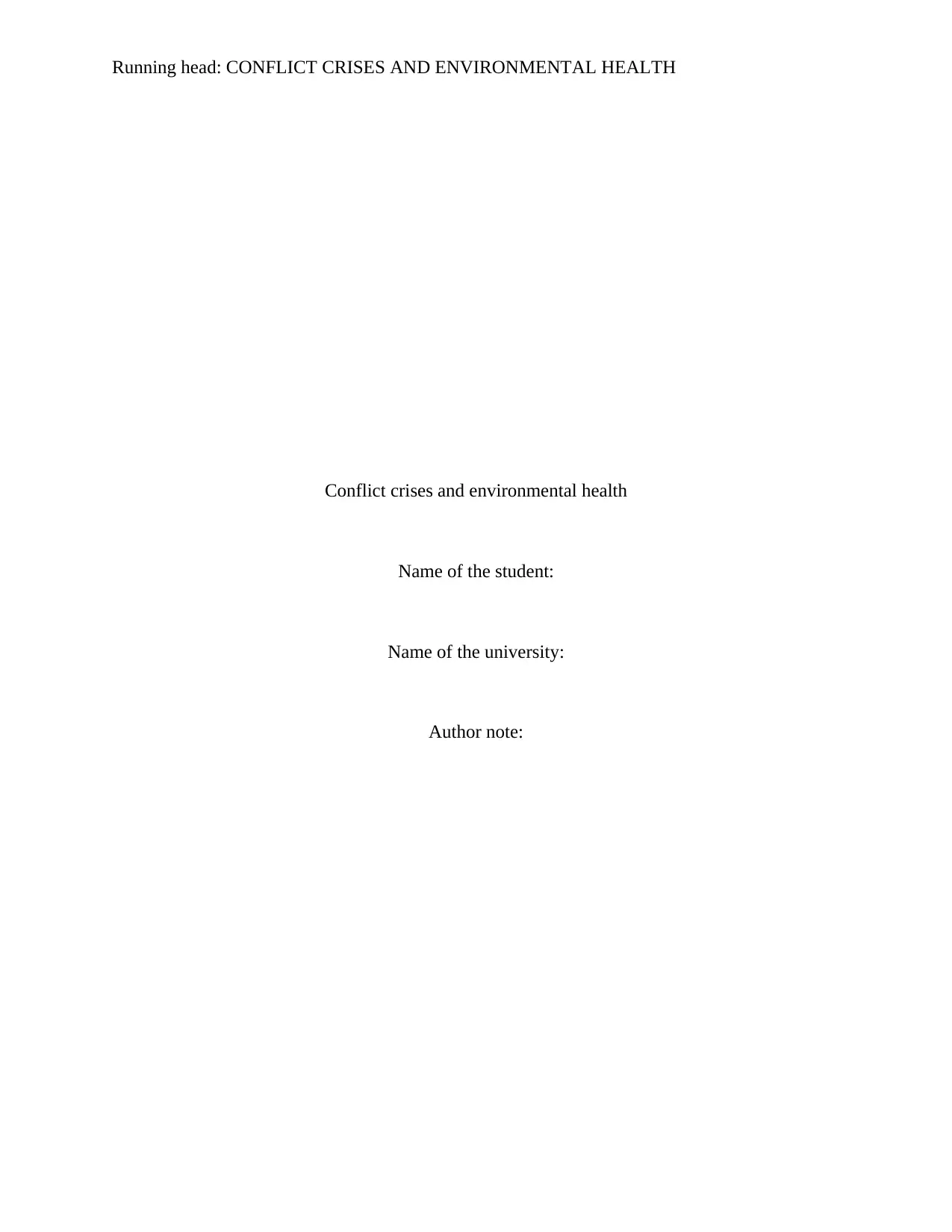
Running head: CONFLICT CRISES AND ENVIRONMENTAL HEALTH
Conflict crises and environmental health
Name of the student:
Name of the university:
Author note:
Conflict crises and environmental health
Name of the student:
Name of the university:
Author note:
Paraphrase This Document
Need a fresh take? Get an instant paraphrase of this document with our AI Paraphraser
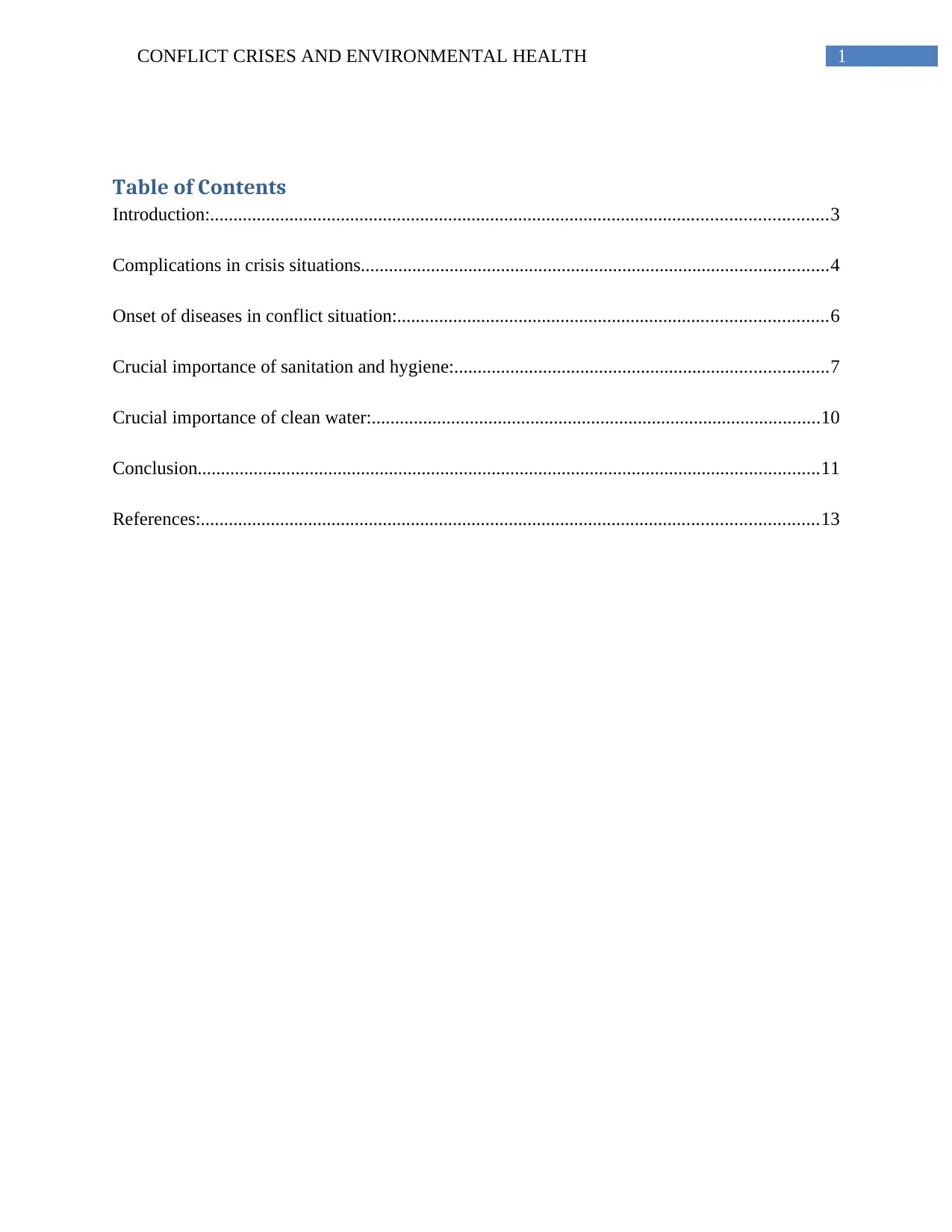
1CONFLICT CRISES AND ENVIRONMENTAL HEALTH
Table of Contents
Introduction:....................................................................................................................................3
Complications in crisis situations....................................................................................................4
Onset of diseases in conflict situation:............................................................................................6
Crucial importance of sanitation and hygiene:................................................................................7
Crucial importance of clean water:................................................................................................10
Conclusion.....................................................................................................................................11
References:....................................................................................................................................13
Table of Contents
Introduction:....................................................................................................................................3
Complications in crisis situations....................................................................................................4
Onset of diseases in conflict situation:............................................................................................6
Crucial importance of sanitation and hygiene:................................................................................7
Crucial importance of clean water:................................................................................................10
Conclusion.....................................................................................................................................11
References:....................................................................................................................................13
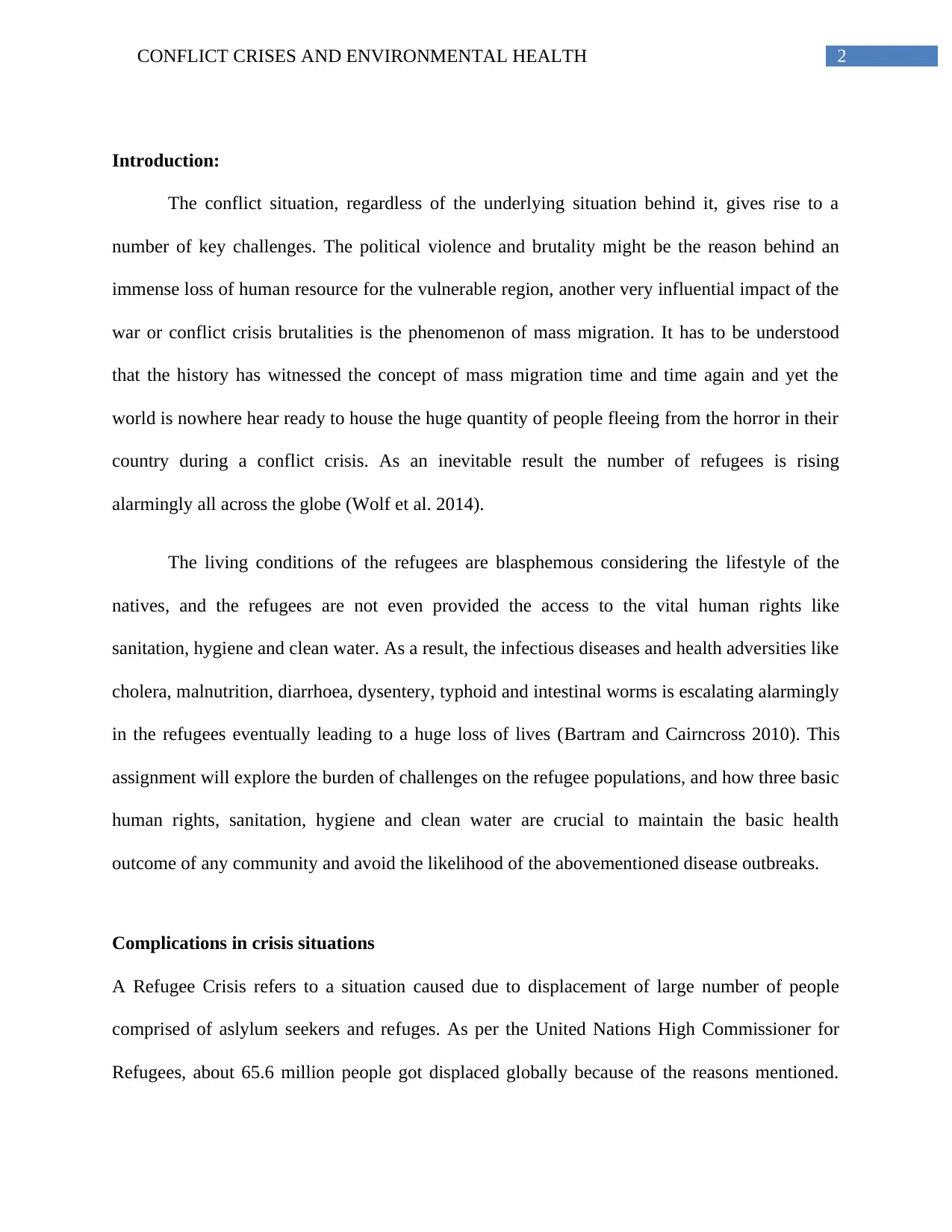
2CONFLICT CRISES AND ENVIRONMENTAL HEALTH
Introduction:
The conflict situation, regardless of the underlying situation behind it, gives rise to a
number of key challenges. The political violence and brutality might be the reason behind an
immense loss of human resource for the vulnerable region, another very influential impact of the
war or conflict crisis brutalities is the phenomenon of mass migration. It has to be understood
that the history has witnessed the concept of mass migration time and time again and yet the
world is nowhere hear ready to house the huge quantity of people fleeing from the horror in their
country during a conflict crisis. As an inevitable result the number of refugees is rising
alarmingly all across the globe (Wolf et al. 2014).
The living conditions of the refugees are blasphemous considering the lifestyle of the
natives, and the refugees are not even provided the access to the vital human rights like
sanitation, hygiene and clean water. As a result, the infectious diseases and health adversities like
cholera, malnutrition, diarrhoea, dysentery, typhoid and intestinal worms is escalating alarmingly
in the refugees eventually leading to a huge loss of lives (Bartram and Cairncross 2010). This
assignment will explore the burden of challenges on the refugee populations, and how three basic
human rights, sanitation, hygiene and clean water are crucial to maintain the basic health
outcome of any community and avoid the likelihood of the abovementioned disease outbreaks.
Complications in crisis situations
A Refugee Crisis refers to a situation caused due to displacement of large number of people
comprised of aslylum seekers and refuges. As per the United Nations High Commissioner for
Refugees, about 65.6 million people got displaced globally because of the reasons mentioned.
Introduction:
The conflict situation, regardless of the underlying situation behind it, gives rise to a
number of key challenges. The political violence and brutality might be the reason behind an
immense loss of human resource for the vulnerable region, another very influential impact of the
war or conflict crisis brutalities is the phenomenon of mass migration. It has to be understood
that the history has witnessed the concept of mass migration time and time again and yet the
world is nowhere hear ready to house the huge quantity of people fleeing from the horror in their
country during a conflict crisis. As an inevitable result the number of refugees is rising
alarmingly all across the globe (Wolf et al. 2014).
The living conditions of the refugees are blasphemous considering the lifestyle of the
natives, and the refugees are not even provided the access to the vital human rights like
sanitation, hygiene and clean water. As a result, the infectious diseases and health adversities like
cholera, malnutrition, diarrhoea, dysentery, typhoid and intestinal worms is escalating alarmingly
in the refugees eventually leading to a huge loss of lives (Bartram and Cairncross 2010). This
assignment will explore the burden of challenges on the refugee populations, and how three basic
human rights, sanitation, hygiene and clean water are crucial to maintain the basic health
outcome of any community and avoid the likelihood of the abovementioned disease outbreaks.
Complications in crisis situations
A Refugee Crisis refers to a situation caused due to displacement of large number of people
comprised of aslylum seekers and refuges. As per the United Nations High Commissioner for
Refugees, about 65.6 million people got displaced globally because of the reasons mentioned.
⊘ This is a preview!⊘
Do you want full access?
Subscribe today to unlock all pages.

Trusted by 1+ million students worldwide

3CONFLICT CRISES AND ENVIRONMENTAL HEALTH
This crisis can be cause because of Wars or civil unrests, Human rights violations (for example
due to corruption in Uganda, Somalia, Nigeria), Environmental Conditions (for example in
Bolivia or Tanzania), Economic Hardships (in third world countries). These displaced people,
end up migrating to the nearest countries where they can seek asylum or refuge, and thereby
causing an enormous influx of people. The temporary refugee camps set up to accommodate
these individuals, are generally aimed to give the basic human necessities during their short
duration of stay. Ideally, these settlements are supposed to have provisions for housing and
sanitation, food rations, provide means of an income and security for the refugees or asylum
seekers, apart from ensuring democracy and justice and well being of these people. However, a
study of several refugee camps shows that such parameters are not consistently maintained, and
an overcrowding of the camps often resulted in deprivation of such facilities to the refugees.
For an example, The Zaatari refugee camp in Jordan houses more than 83,000 people in simple,
temporary tents, which provide very little or almost no protection against sub zero temperatures
or now or flooding (King and Smith, 2015). Similarly, the Congolese refugees in the Nyarugusu
camp in Tanzania have built their own settlements using unbaked bricks, so that they can be
razed at a moment’s notice (Thomson, 2014). This temporary nature of the refugee camps
makes them especially vulnerable to collapse on the long run, or when running at or above
capacity. Because of this, there is an eventual breakdown of the available facilities like
sanitation, water and food supply, and thereby neglecting the basic human necessities. A lack or
shortage of funding to the host countries, political corruption, diplomacy and red-tapism, rebel or
terrorist groups and fragmentation further complicates the situation, preventing the improvement
of the situations seen in the camps. The risk of conflicts becomes even higher when the refugees
This crisis can be cause because of Wars or civil unrests, Human rights violations (for example
due to corruption in Uganda, Somalia, Nigeria), Environmental Conditions (for example in
Bolivia or Tanzania), Economic Hardships (in third world countries). These displaced people,
end up migrating to the nearest countries where they can seek asylum or refuge, and thereby
causing an enormous influx of people. The temporary refugee camps set up to accommodate
these individuals, are generally aimed to give the basic human necessities during their short
duration of stay. Ideally, these settlements are supposed to have provisions for housing and
sanitation, food rations, provide means of an income and security for the refugees or asylum
seekers, apart from ensuring democracy and justice and well being of these people. However, a
study of several refugee camps shows that such parameters are not consistently maintained, and
an overcrowding of the camps often resulted in deprivation of such facilities to the refugees.
For an example, The Zaatari refugee camp in Jordan houses more than 83,000 people in simple,
temporary tents, which provide very little or almost no protection against sub zero temperatures
or now or flooding (King and Smith, 2015). Similarly, the Congolese refugees in the Nyarugusu
camp in Tanzania have built their own settlements using unbaked bricks, so that they can be
razed at a moment’s notice (Thomson, 2014). This temporary nature of the refugee camps
makes them especially vulnerable to collapse on the long run, or when running at or above
capacity. Because of this, there is an eventual breakdown of the available facilities like
sanitation, water and food supply, and thereby neglecting the basic human necessities. A lack or
shortage of funding to the host countries, political corruption, diplomacy and red-tapism, rebel or
terrorist groups and fragmentation further complicates the situation, preventing the improvement
of the situations seen in the camps. The risk of conflicts becomes even higher when the refugees
Paraphrase This Document
Need a fresh take? Get an instant paraphrase of this document with our AI Paraphraser
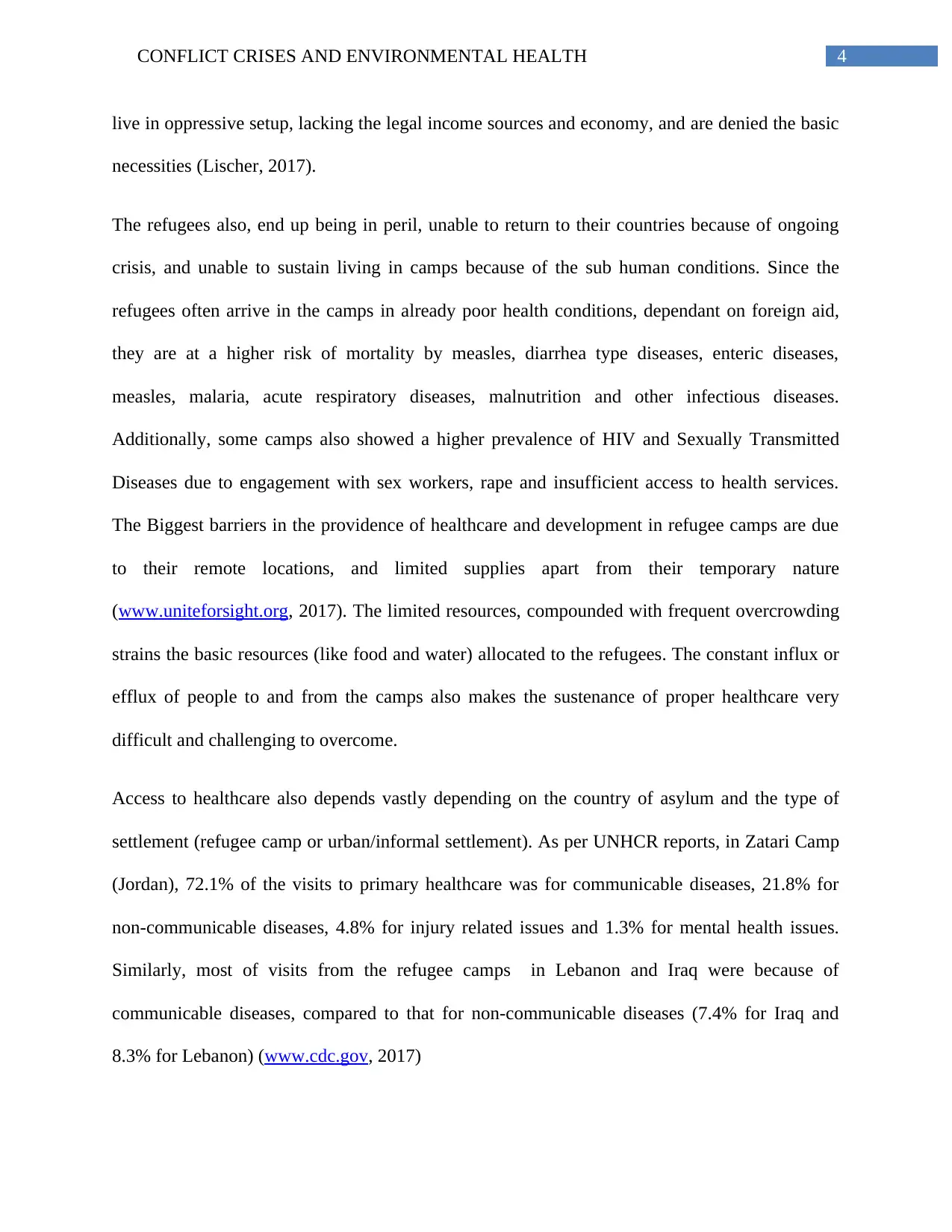
4CONFLICT CRISES AND ENVIRONMENTAL HEALTH
live in oppressive setup, lacking the legal income sources and economy, and are denied the basic
necessities (Lischer, 2017).
The refugees also, end up being in peril, unable to return to their countries because of ongoing
crisis, and unable to sustain living in camps because of the sub human conditions. Since the
refugees often arrive in the camps in already poor health conditions, dependant on foreign aid,
they are at a higher risk of mortality by measles, diarrhea type diseases, enteric diseases,
measles, malaria, acute respiratory diseases, malnutrition and other infectious diseases.
Additionally, some camps also showed a higher prevalence of HIV and Sexually Transmitted
Diseases due to engagement with sex workers, rape and insufficient access to health services.
The Biggest barriers in the providence of healthcare and development in refugee camps are due
to their remote locations, and limited supplies apart from their temporary nature
(www.uniteforsight.org, 2017). The limited resources, compounded with frequent overcrowding
strains the basic resources (like food and water) allocated to the refugees. The constant influx or
efflux of people to and from the camps also makes the sustenance of proper healthcare very
difficult and challenging to overcome.
Access to healthcare also depends vastly depending on the country of asylum and the type of
settlement (refugee camp or urban/informal settlement). As per UNHCR reports, in Zatari Camp
(Jordan), 72.1% of the visits to primary healthcare was for communicable diseases, 21.8% for
non-communicable diseases, 4.8% for injury related issues and 1.3% for mental health issues.
Similarly, most of visits from the refugee camps in Lebanon and Iraq were because of
communicable diseases, compared to that for non-communicable diseases (7.4% for Iraq and
8.3% for Lebanon) (www.cdc.gov, 2017)
live in oppressive setup, lacking the legal income sources and economy, and are denied the basic
necessities (Lischer, 2017).
The refugees also, end up being in peril, unable to return to their countries because of ongoing
crisis, and unable to sustain living in camps because of the sub human conditions. Since the
refugees often arrive in the camps in already poor health conditions, dependant on foreign aid,
they are at a higher risk of mortality by measles, diarrhea type diseases, enteric diseases,
measles, malaria, acute respiratory diseases, malnutrition and other infectious diseases.
Additionally, some camps also showed a higher prevalence of HIV and Sexually Transmitted
Diseases due to engagement with sex workers, rape and insufficient access to health services.
The Biggest barriers in the providence of healthcare and development in refugee camps are due
to their remote locations, and limited supplies apart from their temporary nature
(www.uniteforsight.org, 2017). The limited resources, compounded with frequent overcrowding
strains the basic resources (like food and water) allocated to the refugees. The constant influx or
efflux of people to and from the camps also makes the sustenance of proper healthcare very
difficult and challenging to overcome.
Access to healthcare also depends vastly depending on the country of asylum and the type of
settlement (refugee camp or urban/informal settlement). As per UNHCR reports, in Zatari Camp
(Jordan), 72.1% of the visits to primary healthcare was for communicable diseases, 21.8% for
non-communicable diseases, 4.8% for injury related issues and 1.3% for mental health issues.
Similarly, most of visits from the refugee camps in Lebanon and Iraq were because of
communicable diseases, compared to that for non-communicable diseases (7.4% for Iraq and
8.3% for Lebanon) (www.cdc.gov, 2017)
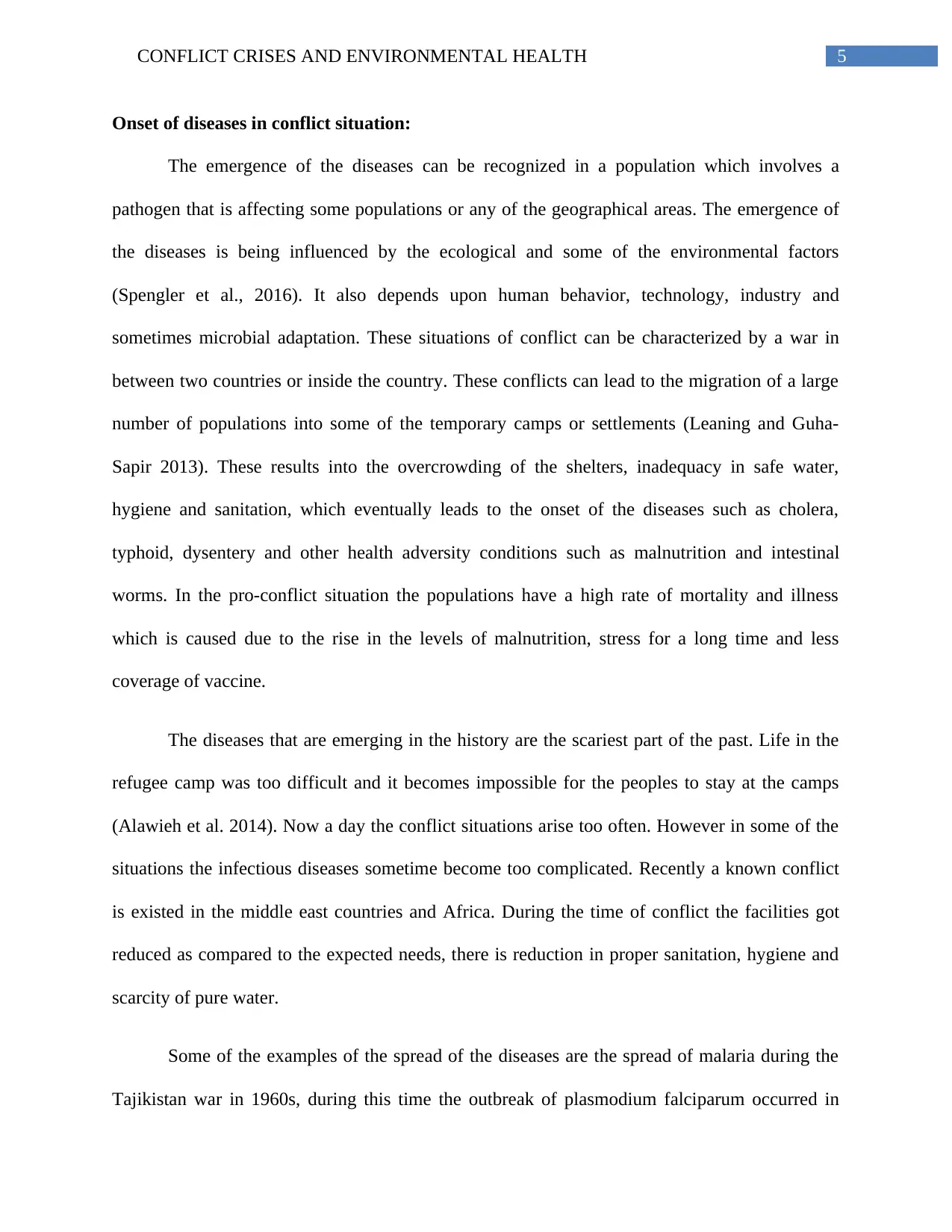
5CONFLICT CRISES AND ENVIRONMENTAL HEALTH
Onset of diseases in conflict situation:
The emergence of the diseases can be recognized in a population which involves a
pathogen that is affecting some populations or any of the geographical areas. The emergence of
the diseases is being influenced by the ecological and some of the environmental factors
(Spengler et al., 2016). It also depends upon human behavior, technology, industry and
sometimes microbial adaptation. These situations of conflict can be characterized by a war in
between two countries or inside the country. These conflicts can lead to the migration of a large
number of populations into some of the temporary camps or settlements (Leaning and Guha-
Sapir 2013). These results into the overcrowding of the shelters, inadequacy in safe water,
hygiene and sanitation, which eventually leads to the onset of the diseases such as cholera,
typhoid, dysentery and other health adversity conditions such as malnutrition and intestinal
worms. In the pro-conflict situation the populations have a high rate of mortality and illness
which is caused due to the rise in the levels of malnutrition, stress for a long time and less
coverage of vaccine.
The diseases that are emerging in the history are the scariest part of the past. Life in the
refugee camp was too difficult and it becomes impossible for the peoples to stay at the camps
(Alawieh et al. 2014). Now a day the conflict situations arise too often. However in some of the
situations the infectious diseases sometime become too complicated. Recently a known conflict
is existed in the middle east countries and Africa. During the time of conflict the facilities got
reduced as compared to the expected needs, there is reduction in proper sanitation, hygiene and
scarcity of pure water.
Some of the examples of the spread of the diseases are the spread of malaria during the
Tajikistan war in 1960s, during this time the outbreak of plasmodium falciparum occurred in
Onset of diseases in conflict situation:
The emergence of the diseases can be recognized in a population which involves a
pathogen that is affecting some populations or any of the geographical areas. The emergence of
the diseases is being influenced by the ecological and some of the environmental factors
(Spengler et al., 2016). It also depends upon human behavior, technology, industry and
sometimes microbial adaptation. These situations of conflict can be characterized by a war in
between two countries or inside the country. These conflicts can lead to the migration of a large
number of populations into some of the temporary camps or settlements (Leaning and Guha-
Sapir 2013). These results into the overcrowding of the shelters, inadequacy in safe water,
hygiene and sanitation, which eventually leads to the onset of the diseases such as cholera,
typhoid, dysentery and other health adversity conditions such as malnutrition and intestinal
worms. In the pro-conflict situation the populations have a high rate of mortality and illness
which is caused due to the rise in the levels of malnutrition, stress for a long time and less
coverage of vaccine.
The diseases that are emerging in the history are the scariest part of the past. Life in the
refugee camp was too difficult and it becomes impossible for the peoples to stay at the camps
(Alawieh et al. 2014). Now a day the conflict situations arise too often. However in some of the
situations the infectious diseases sometime become too complicated. Recently a known conflict
is existed in the middle east countries and Africa. During the time of conflict the facilities got
reduced as compared to the expected needs, there is reduction in proper sanitation, hygiene and
scarcity of pure water.
Some of the examples of the spread of the diseases are the spread of malaria during the
Tajikistan war in 1960s, during this time the outbreak of plasmodium falciparum occurred in
⊘ This is a preview!⊘
Do you want full access?
Subscribe today to unlock all pages.

Trusted by 1+ million students worldwide
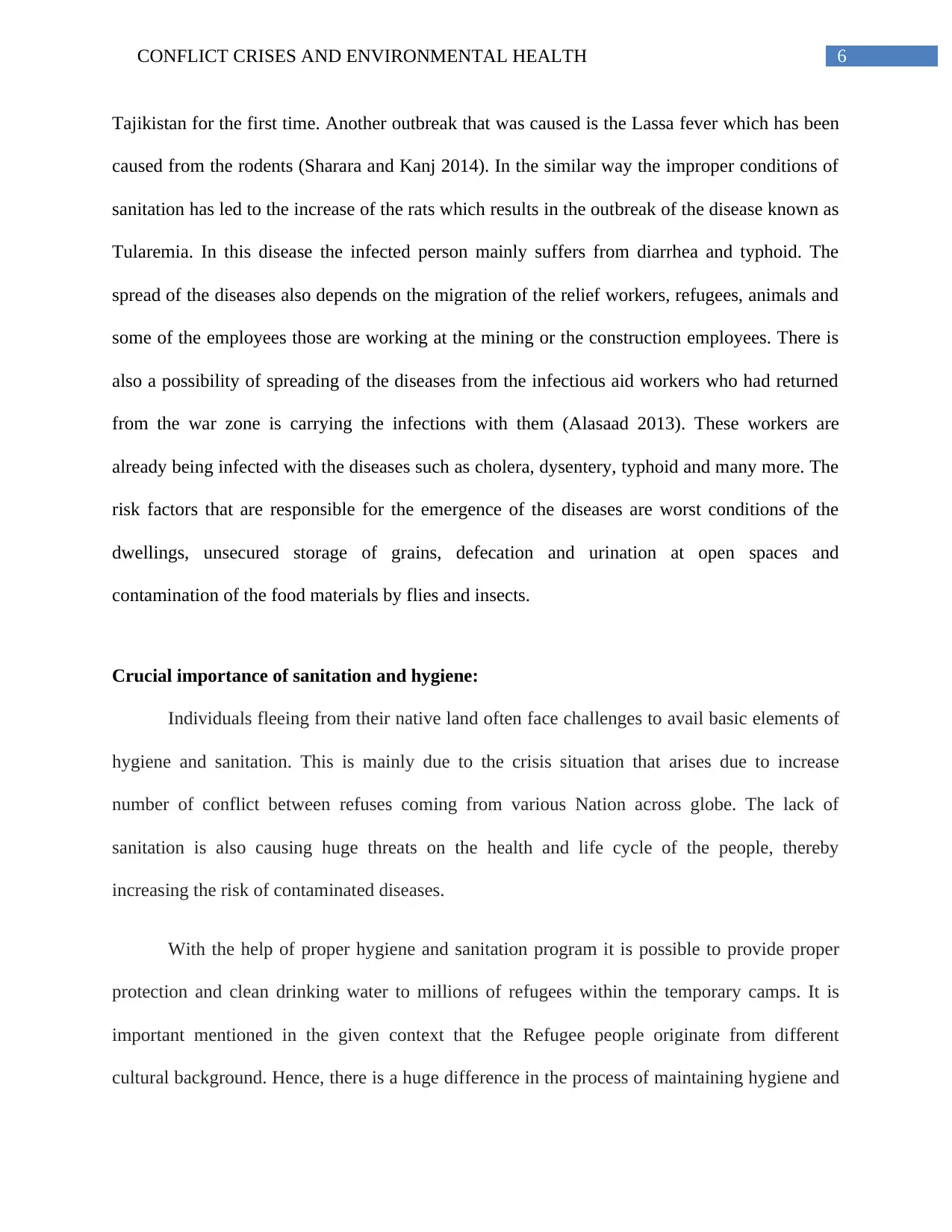
6CONFLICT CRISES AND ENVIRONMENTAL HEALTH
Tajikistan for the first time. Another outbreak that was caused is the Lassa fever which has been
caused from the rodents (Sharara and Kanj 2014). In the similar way the improper conditions of
sanitation has led to the increase of the rats which results in the outbreak of the disease known as
Tularemia. In this disease the infected person mainly suffers from diarrhea and typhoid. The
spread of the diseases also depends on the migration of the relief workers, refugees, animals and
some of the employees those are working at the mining or the construction employees. There is
also a possibility of spreading of the diseases from the infectious aid workers who had returned
from the war zone is carrying the infections with them (Alasaad 2013). These workers are
already being infected with the diseases such as cholera, dysentery, typhoid and many more. The
risk factors that are responsible for the emergence of the diseases are worst conditions of the
dwellings, unsecured storage of grains, defecation and urination at open spaces and
contamination of the food materials by flies and insects.
Crucial importance of sanitation and hygiene:
Individuals fleeing from their native land often face challenges to avail basic elements of
hygiene and sanitation. This is mainly due to the crisis situation that arises due to increase
number of conflict between refuses coming from various Nation across globe. The lack of
sanitation is also causing huge threats on the health and life cycle of the people, thereby
increasing the risk of contaminated diseases.
With the help of proper hygiene and sanitation program it is possible to provide proper
protection and clean drinking water to millions of refugees within the temporary camps. It is
important mentioned in the given context that the Refugee people originate from different
cultural background. Hence, there is a huge difference in the process of maintaining hygiene and
Tajikistan for the first time. Another outbreak that was caused is the Lassa fever which has been
caused from the rodents (Sharara and Kanj 2014). In the similar way the improper conditions of
sanitation has led to the increase of the rats which results in the outbreak of the disease known as
Tularemia. In this disease the infected person mainly suffers from diarrhea and typhoid. The
spread of the diseases also depends on the migration of the relief workers, refugees, animals and
some of the employees those are working at the mining or the construction employees. There is
also a possibility of spreading of the diseases from the infectious aid workers who had returned
from the war zone is carrying the infections with them (Alasaad 2013). These workers are
already being infected with the diseases such as cholera, dysentery, typhoid and many more. The
risk factors that are responsible for the emergence of the diseases are worst conditions of the
dwellings, unsecured storage of grains, defecation and urination at open spaces and
contamination of the food materials by flies and insects.
Crucial importance of sanitation and hygiene:
Individuals fleeing from their native land often face challenges to avail basic elements of
hygiene and sanitation. This is mainly due to the crisis situation that arises due to increase
number of conflict between refuses coming from various Nation across globe. The lack of
sanitation is also causing huge threats on the health and life cycle of the people, thereby
increasing the risk of contaminated diseases.
With the help of proper hygiene and sanitation program it is possible to provide proper
protection and clean drinking water to millions of refugees within the temporary camps. It is
important mentioned in the given context that the Refugee people originate from different
cultural background. Hence, there is a huge difference in the process of maintaining hygiene and
Paraphrase This Document
Need a fresh take? Get an instant paraphrase of this document with our AI Paraphraser
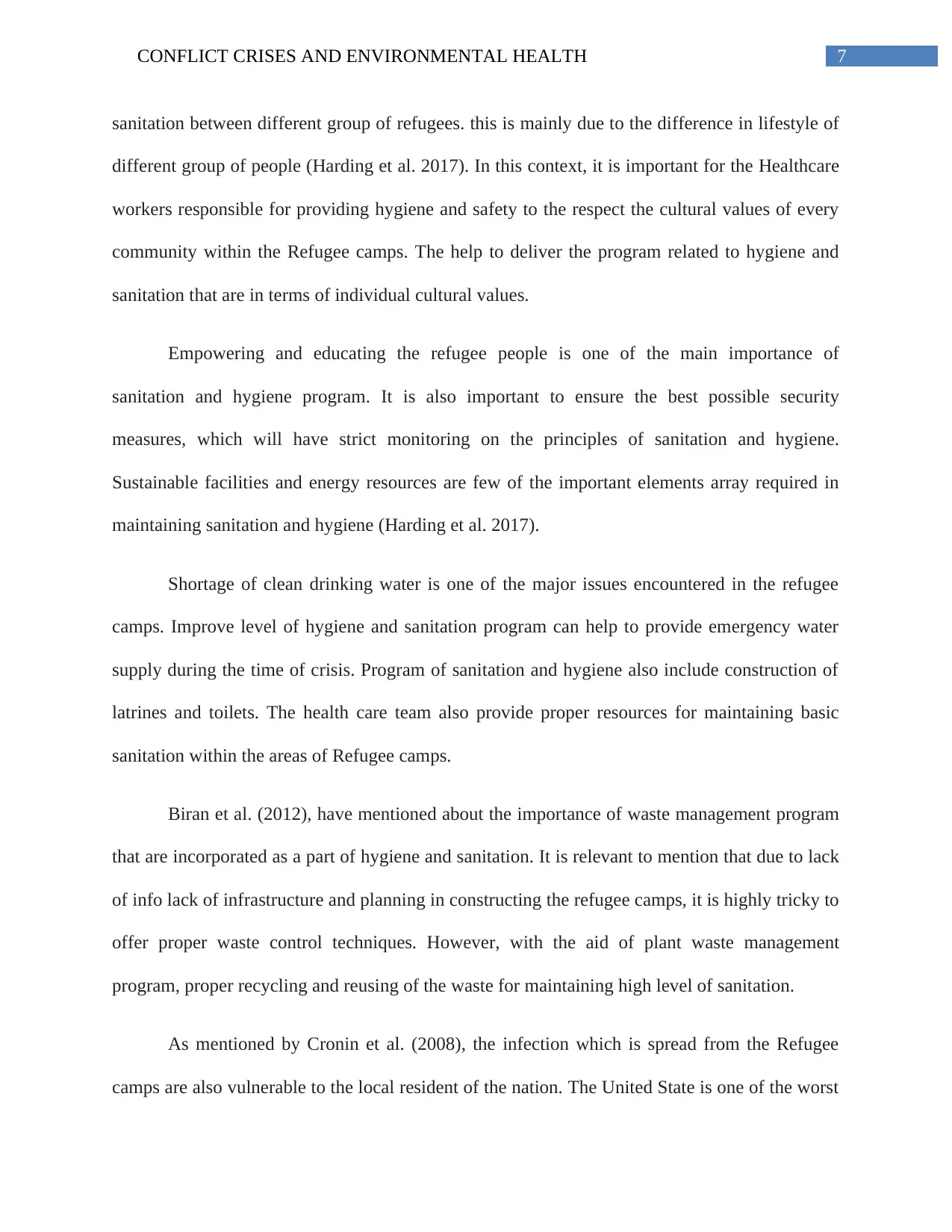
7CONFLICT CRISES AND ENVIRONMENTAL HEALTH
sanitation between different group of refugees. this is mainly due to the difference in lifestyle of
different group of people (Harding et al. 2017). In this context, it is important for the Healthcare
workers responsible for providing hygiene and safety to the respect the cultural values of every
community within the Refugee camps. The help to deliver the program related to hygiene and
sanitation that are in terms of individual cultural values.
Empowering and educating the refugee people is one of the main importance of
sanitation and hygiene program. It is also important to ensure the best possible security
measures, which will have strict monitoring on the principles of sanitation and hygiene.
Sustainable facilities and energy resources are few of the important elements array required in
maintaining sanitation and hygiene (Harding et al. 2017).
Shortage of clean drinking water is one of the major issues encountered in the refugee
camps. Improve level of hygiene and sanitation program can help to provide emergency water
supply during the time of crisis. Program of sanitation and hygiene also include construction of
latrines and toilets. The health care team also provide proper resources for maintaining basic
sanitation within the areas of Refugee camps.
Biran et al. (2012), have mentioned about the importance of waste management program
that are incorporated as a part of hygiene and sanitation. It is relevant to mention that due to lack
of info lack of infrastructure and planning in constructing the refugee camps, it is highly tricky to
offer proper waste control techniques. However, with the aid of plant waste management
program, proper recycling and reusing of the waste for maintaining high level of sanitation.
As mentioned by Cronin et al. (2008), the infection which is spread from the Refugee
camps are also vulnerable to the local resident of the nation. The United State is one of the worst
sanitation between different group of refugees. this is mainly due to the difference in lifestyle of
different group of people (Harding et al. 2017). In this context, it is important for the Healthcare
workers responsible for providing hygiene and safety to the respect the cultural values of every
community within the Refugee camps. The help to deliver the program related to hygiene and
sanitation that are in terms of individual cultural values.
Empowering and educating the refugee people is one of the main importance of
sanitation and hygiene program. It is also important to ensure the best possible security
measures, which will have strict monitoring on the principles of sanitation and hygiene.
Sustainable facilities and energy resources are few of the important elements array required in
maintaining sanitation and hygiene (Harding et al. 2017).
Shortage of clean drinking water is one of the major issues encountered in the refugee
camps. Improve level of hygiene and sanitation program can help to provide emergency water
supply during the time of crisis. Program of sanitation and hygiene also include construction of
latrines and toilets. The health care team also provide proper resources for maintaining basic
sanitation within the areas of Refugee camps.
Biran et al. (2012), have mentioned about the importance of waste management program
that are incorporated as a part of hygiene and sanitation. It is relevant to mention that due to lack
of info lack of infrastructure and planning in constructing the refugee camps, it is highly tricky to
offer proper waste control techniques. However, with the aid of plant waste management
program, proper recycling and reusing of the waste for maintaining high level of sanitation.
As mentioned by Cronin et al. (2008), the infection which is spread from the Refugee
camps are also vulnerable to the local resident of the nation. The United State is one of the worst
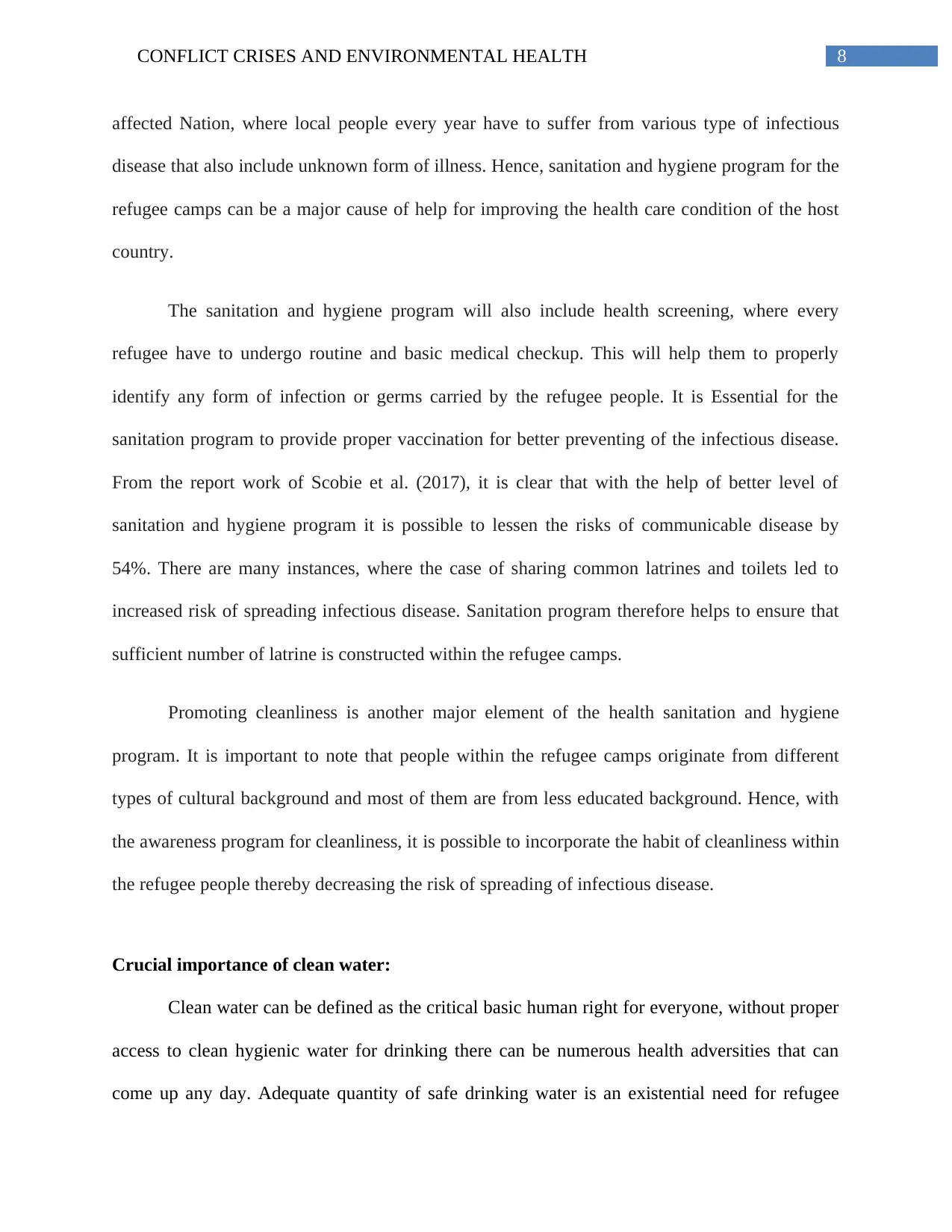
8CONFLICT CRISES AND ENVIRONMENTAL HEALTH
affected Nation, where local people every year have to suffer from various type of infectious
disease that also include unknown form of illness. Hence, sanitation and hygiene program for the
refugee camps can be a major cause of help for improving the health care condition of the host
country.
The sanitation and hygiene program will also include health screening, where every
refugee have to undergo routine and basic medical checkup. This will help them to properly
identify any form of infection or germs carried by the refugee people. It is Essential for the
sanitation program to provide proper vaccination for better preventing of the infectious disease.
From the report work of Scobie et al. (2017), it is clear that with the help of better level of
sanitation and hygiene program it is possible to lessen the risks of communicable disease by
54%. There are many instances, where the case of sharing common latrines and toilets led to
increased risk of spreading infectious disease. Sanitation program therefore helps to ensure that
sufficient number of latrine is constructed within the refugee camps.
Promoting cleanliness is another major element of the health sanitation and hygiene
program. It is important to note that people within the refugee camps originate from different
types of cultural background and most of them are from less educated background. Hence, with
the awareness program for cleanliness, it is possible to incorporate the habit of cleanliness within
the refugee people thereby decreasing the risk of spreading of infectious disease.
Crucial importance of clean water:
Clean water can be defined as the critical basic human right for everyone, without proper
access to clean hygienic water for drinking there can be numerous health adversities that can
come up any day. Adequate quantity of safe drinking water is an existential need for refugee
affected Nation, where local people every year have to suffer from various type of infectious
disease that also include unknown form of illness. Hence, sanitation and hygiene program for the
refugee camps can be a major cause of help for improving the health care condition of the host
country.
The sanitation and hygiene program will also include health screening, where every
refugee have to undergo routine and basic medical checkup. This will help them to properly
identify any form of infection or germs carried by the refugee people. It is Essential for the
sanitation program to provide proper vaccination for better preventing of the infectious disease.
From the report work of Scobie et al. (2017), it is clear that with the help of better level of
sanitation and hygiene program it is possible to lessen the risks of communicable disease by
54%. There are many instances, where the case of sharing common latrines and toilets led to
increased risk of spreading infectious disease. Sanitation program therefore helps to ensure that
sufficient number of latrine is constructed within the refugee camps.
Promoting cleanliness is another major element of the health sanitation and hygiene
program. It is important to note that people within the refugee camps originate from different
types of cultural background and most of them are from less educated background. Hence, with
the awareness program for cleanliness, it is possible to incorporate the habit of cleanliness within
the refugee people thereby decreasing the risk of spreading of infectious disease.
Crucial importance of clean water:
Clean water can be defined as the critical basic human right for everyone, without proper
access to clean hygienic water for drinking there can be numerous health adversities that can
come up any day. Adequate quantity of safe drinking water is an existential need for refugee
⊘ This is a preview!⊘
Do you want full access?
Subscribe today to unlock all pages.

Trusted by 1+ million students worldwide
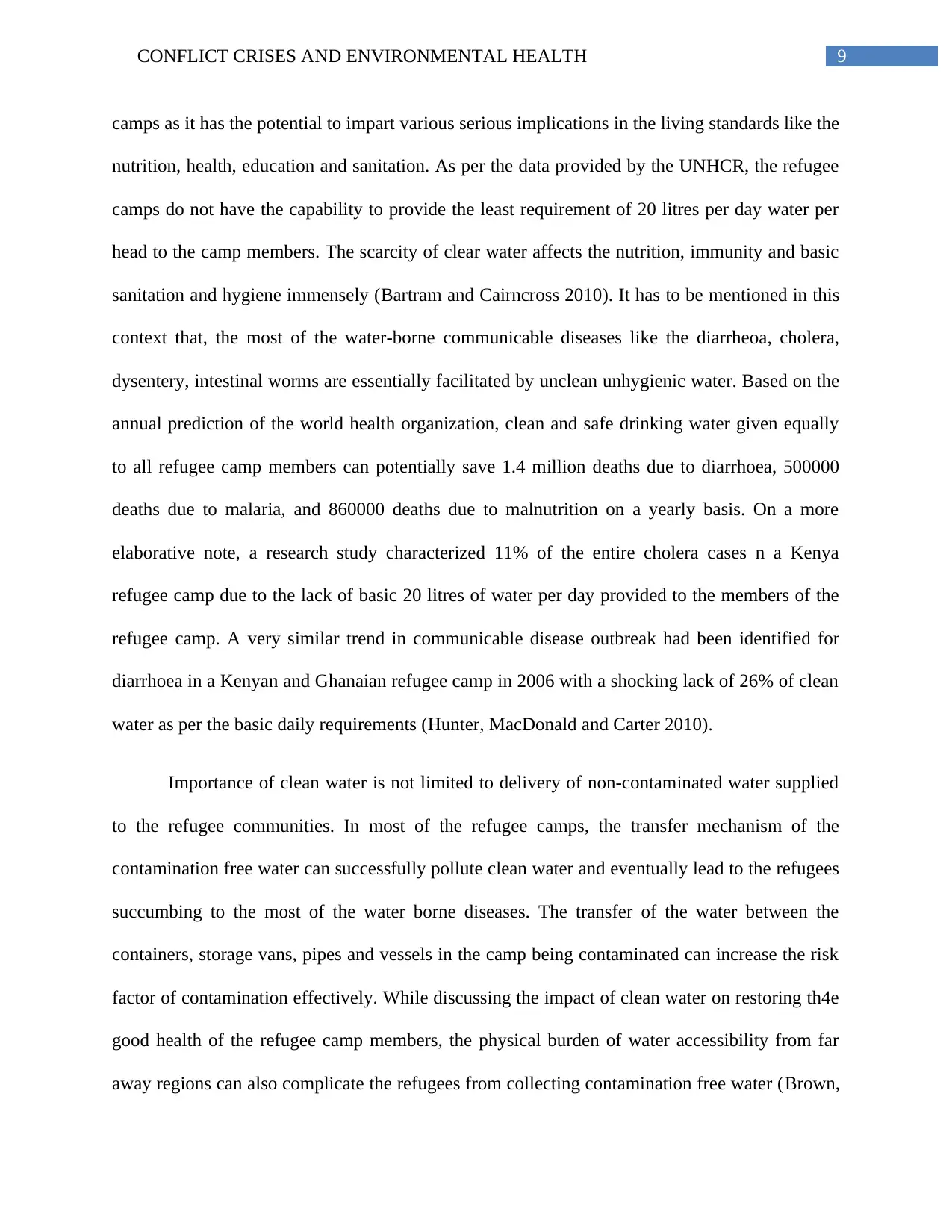
9CONFLICT CRISES AND ENVIRONMENTAL HEALTH
camps as it has the potential to impart various serious implications in the living standards like the
nutrition, health, education and sanitation. As per the data provided by the UNHCR, the refugee
camps do not have the capability to provide the least requirement of 20 litres per day water per
head to the camp members. The scarcity of clear water affects the nutrition, immunity and basic
sanitation and hygiene immensely (Bartram and Cairncross 2010). It has to be mentioned in this
context that, the most of the water-borne communicable diseases like the diarrheoa, cholera,
dysentery, intestinal worms are essentially facilitated by unclean unhygienic water. Based on the
annual prediction of the world health organization, clean and safe drinking water given equally
to all refugee camp members can potentially save 1.4 million deaths due to diarrhoea, 500000
deaths due to malaria, and 860000 deaths due to malnutrition on a yearly basis. On a more
elaborative note, a research study characterized 11% of the entire cholera cases n a Kenya
refugee camp due to the lack of basic 20 litres of water per day provided to the members of the
refugee camp. A very similar trend in communicable disease outbreak had been identified for
diarrhoea in a Kenyan and Ghanaian refugee camp in 2006 with a shocking lack of 26% of clean
water as per the basic daily requirements (Hunter, MacDonald and Carter 2010).
Importance of clean water is not limited to delivery of non-contaminated water supplied
to the refugee communities. In most of the refugee camps, the transfer mechanism of the
contamination free water can successfully pollute clean water and eventually lead to the refugees
succumbing to the most of the water borne diseases. The transfer of the water between the
containers, storage vans, pipes and vessels in the camp being contaminated can increase the risk
factor of contamination effectively. While discussing the impact of clean water on restoring th4e
good health of the refugee camp members, the physical burden of water accessibility from far
away regions can also complicate the refugees from collecting contamination free water (Brown,
camps as it has the potential to impart various serious implications in the living standards like the
nutrition, health, education and sanitation. As per the data provided by the UNHCR, the refugee
camps do not have the capability to provide the least requirement of 20 litres per day water per
head to the camp members. The scarcity of clear water affects the nutrition, immunity and basic
sanitation and hygiene immensely (Bartram and Cairncross 2010). It has to be mentioned in this
context that, the most of the water-borne communicable diseases like the diarrheoa, cholera,
dysentery, intestinal worms are essentially facilitated by unclean unhygienic water. Based on the
annual prediction of the world health organization, clean and safe drinking water given equally
to all refugee camp members can potentially save 1.4 million deaths due to diarrhoea, 500000
deaths due to malaria, and 860000 deaths due to malnutrition on a yearly basis. On a more
elaborative note, a research study characterized 11% of the entire cholera cases n a Kenya
refugee camp due to the lack of basic 20 litres of water per day provided to the members of the
refugee camp. A very similar trend in communicable disease outbreak had been identified for
diarrhoea in a Kenyan and Ghanaian refugee camp in 2006 with a shocking lack of 26% of clean
water as per the basic daily requirements (Hunter, MacDonald and Carter 2010).
Importance of clean water is not limited to delivery of non-contaminated water supplied
to the refugee communities. In most of the refugee camps, the transfer mechanism of the
contamination free water can successfully pollute clean water and eventually lead to the refugees
succumbing to the most of the water borne diseases. The transfer of the water between the
containers, storage vans, pipes and vessels in the camp being contaminated can increase the risk
factor of contamination effectively. While discussing the impact of clean water on restoring th4e
good health of the refugee camp members, the physical burden of water accessibility from far
away regions can also complicate the refugees from collecting contamination free water (Brown,
Paraphrase This Document
Need a fresh take? Get an instant paraphrase of this document with our AI Paraphraser
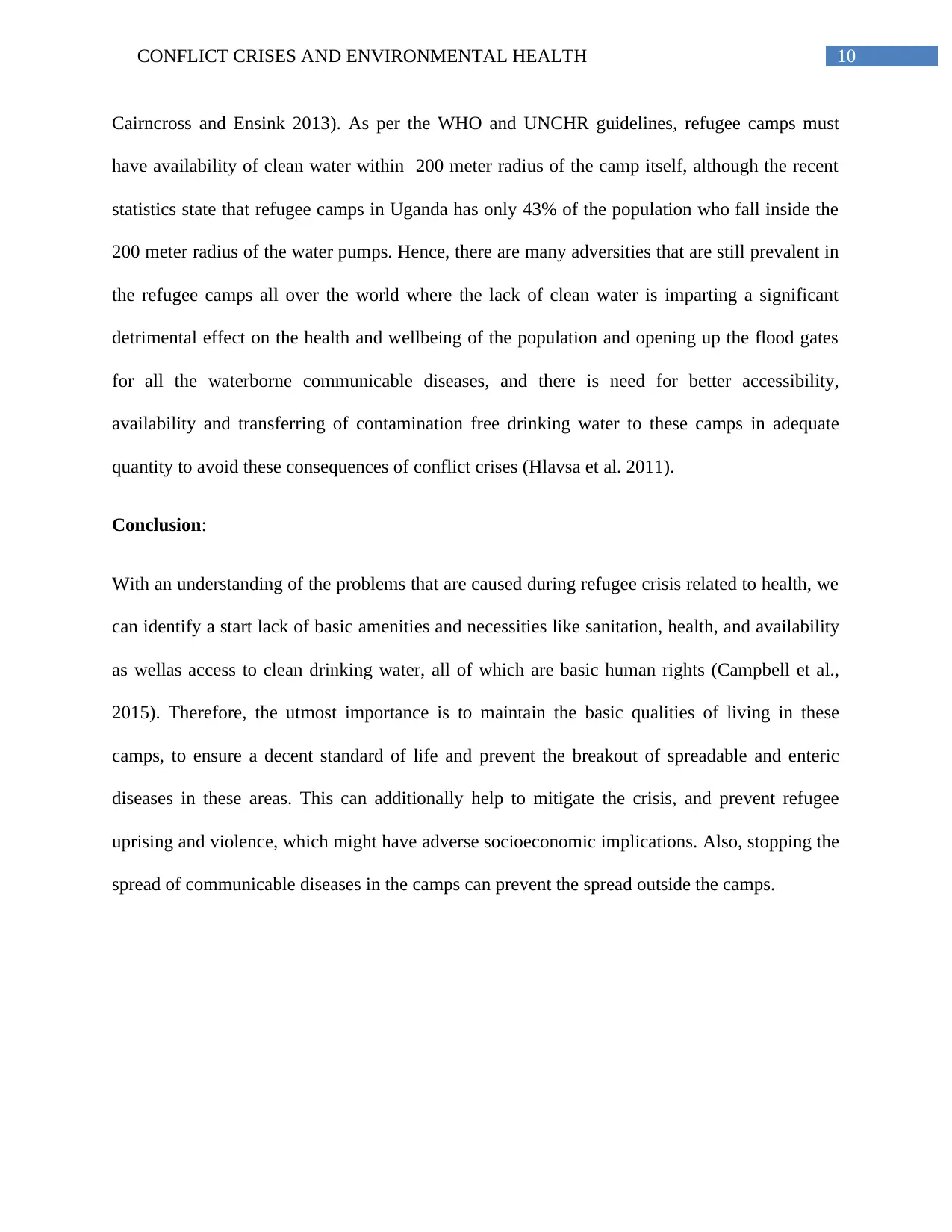
10CONFLICT CRISES AND ENVIRONMENTAL HEALTH
Cairncross and Ensink 2013). As per the WHO and UNCHR guidelines, refugee camps must
have availability of clean water within 200 meter radius of the camp itself, although the recent
statistics state that refugee camps in Uganda has only 43% of the population who fall inside the
200 meter radius of the water pumps. Hence, there are many adversities that are still prevalent in
the refugee camps all over the world where the lack of clean water is imparting a significant
detrimental effect on the health and wellbeing of the population and opening up the flood gates
for all the waterborne communicable diseases, and there is need for better accessibility,
availability and transferring of contamination free drinking water to these camps in adequate
quantity to avoid these consequences of conflict crises (Hlavsa et al. 2011).
Conclusion:
With an understanding of the problems that are caused during refugee crisis related to health, we
can identify a start lack of basic amenities and necessities like sanitation, health, and availability
as wellas access to clean drinking water, all of which are basic human rights (Campbell et al.,
2015). Therefore, the utmost importance is to maintain the basic qualities of living in these
camps, to ensure a decent standard of life and prevent the breakout of spreadable and enteric
diseases in these areas. This can additionally help to mitigate the crisis, and prevent refugee
uprising and violence, which might have adverse socioeconomic implications. Also, stopping the
spread of communicable diseases in the camps can prevent the spread outside the camps.
Cairncross and Ensink 2013). As per the WHO and UNCHR guidelines, refugee camps must
have availability of clean water within 200 meter radius of the camp itself, although the recent
statistics state that refugee camps in Uganda has only 43% of the population who fall inside the
200 meter radius of the water pumps. Hence, there are many adversities that are still prevalent in
the refugee camps all over the world where the lack of clean water is imparting a significant
detrimental effect on the health and wellbeing of the population and opening up the flood gates
for all the waterborne communicable diseases, and there is need for better accessibility,
availability and transferring of contamination free drinking water to these camps in adequate
quantity to avoid these consequences of conflict crises (Hlavsa et al. 2011).
Conclusion:
With an understanding of the problems that are caused during refugee crisis related to health, we
can identify a start lack of basic amenities and necessities like sanitation, health, and availability
as wellas access to clean drinking water, all of which are basic human rights (Campbell et al.,
2015). Therefore, the utmost importance is to maintain the basic qualities of living in these
camps, to ensure a decent standard of life and prevent the breakout of spreadable and enteric
diseases in these areas. This can additionally help to mitigate the crisis, and prevent refugee
uprising and violence, which might have adverse socioeconomic implications. Also, stopping the
spread of communicable diseases in the camps can prevent the spread outside the camps.

11CONFLICT CRISES AND ENVIRONMENTAL HEALTH
References:
Alasaad, S., 2013. War diseases revealed by the social media: massive leishmaniasis outbreak in
the Syrian Spring. Parasites & vectors, 6(1), p.94.
Alawieh, A., Musharrafieh, U., Jaber, A., Berry, A., Ghosn, N. and Bizri, A.R., 2014. Revisiting
leishmaniasis in the time of war: the Syrian conflict and the Lebanese outbreak. International
Journal of Infectious Diseases, 29, pp.115-119.
Bartram, J. and Cairncross, S., 2010. Hygiene, sanitation, and water: forgotten foundations of
health. PLoS medicine, 7(11), p.e1000367.
Biran, A., Schmidt, W.P., Zeleke, L., Emukule, H., Khay, H., Parker, J. and Peprah, D., 2012.
Hygiene and sanitation practices amongst residents of three long‐term refugee camps in
Thailand, Ethiopia and Kenya. Tropical medicine & international health, 17(9), pp.1133-1141.
Brown, J., Cairncross, S. and Ensink, J.H., 2013. Water, sanitation, hygiene and enteric
infections in children. Archives of disease in childhood, pp.archdischild-2011.
Campbell, O.M., Benova, L., Gon, G., Afsana, K. and Cumming, O., 2015. Getting the basic
rights–the role of water, sanitation and hygiene in maternal and reproductive health: a conceptual
framework. Tropical medicine & international health, 20(3), pp.252-267.
Cronin, A.A., Shrestha, D., Cornier, N., Abdalla, F., Ezard, N. and Aramburu, C., 2008. A
review of water and sanitation provision in refugee camps in association with selected health and
nutrition indicators–the need for integrated service provision. Journal of water and health, 6(1),
pp.1-13.
References:
Alasaad, S., 2013. War diseases revealed by the social media: massive leishmaniasis outbreak in
the Syrian Spring. Parasites & vectors, 6(1), p.94.
Alawieh, A., Musharrafieh, U., Jaber, A., Berry, A., Ghosn, N. and Bizri, A.R., 2014. Revisiting
leishmaniasis in the time of war: the Syrian conflict and the Lebanese outbreak. International
Journal of Infectious Diseases, 29, pp.115-119.
Bartram, J. and Cairncross, S., 2010. Hygiene, sanitation, and water: forgotten foundations of
health. PLoS medicine, 7(11), p.e1000367.
Biran, A., Schmidt, W.P., Zeleke, L., Emukule, H., Khay, H., Parker, J. and Peprah, D., 2012.
Hygiene and sanitation practices amongst residents of three long‐term refugee camps in
Thailand, Ethiopia and Kenya. Tropical medicine & international health, 17(9), pp.1133-1141.
Brown, J., Cairncross, S. and Ensink, J.H., 2013. Water, sanitation, hygiene and enteric
infections in children. Archives of disease in childhood, pp.archdischild-2011.
Campbell, O.M., Benova, L., Gon, G., Afsana, K. and Cumming, O., 2015. Getting the basic
rights–the role of water, sanitation and hygiene in maternal and reproductive health: a conceptual
framework. Tropical medicine & international health, 20(3), pp.252-267.
Cronin, A.A., Shrestha, D., Cornier, N., Abdalla, F., Ezard, N. and Aramburu, C., 2008. A
review of water and sanitation provision in refugee camps in association with selected health and
nutrition indicators–the need for integrated service provision. Journal of water and health, 6(1),
pp.1-13.
⊘ This is a preview!⊘
Do you want full access?
Subscribe today to unlock all pages.

Trusted by 1+ million students worldwide
1 out of 15
Related Documents
Your All-in-One AI-Powered Toolkit for Academic Success.
+13062052269
info@desklib.com
Available 24*7 on WhatsApp / Email
![[object Object]](/_next/static/media/star-bottom.7253800d.svg)
Unlock your academic potential
Copyright © 2020–2025 A2Z Services. All Rights Reserved. Developed and managed by ZUCOL.





